|
|
Sans Souci

|
|
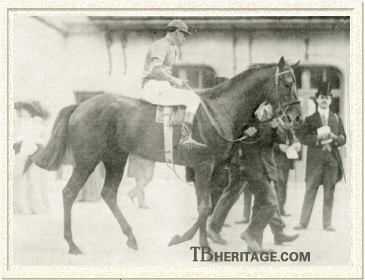 |
|
|
Sans Souci was a key stallion in the Hermit sire line, nurtured for over five generations at Haras de Meautry, the principal French stud of generations of the Rothschild family. A winner of the Grand Prix de Paris and other important races, his offspring were mostly stayers, and tended to pass that ability to their descendants. He got some good sire sons, and many successful broodmare daughters that influenced French pedigrees for years into the future.
His grandsire, Heaume (1887, by Hermit - Bella), established Hermit's sire line in France, where it was the most successful and long-lived branch of sire sons descending from Hermit. Heaume, a chestnut, was out of the British-bred Bella (1873, by Breadalbane, Family 20 - a), a foundation broodmare at Meautry; her daughter, Belladonna produced Bellezza, Brenta (ancestress of Arc winner Tantieme), and Beaute de Neige, the latter dam of thirteen winners, includng French Guineas winner Mont Blanc, Jockey Club Cup winner Mont Bernina and Grand Critérium winner Téléférique. Téléférique was later a successful sire at Meautry. Bella was also, through daughter Sardoine (1894, by Le Sancy), and her descendants bred at Meautry, third dam of SANDARQUE (1911), by Sans Souci, who produced the Rothschild-owned Prix Royal-Oak winner Stearine (1916, by St. Just), herself later dam of seven winners.
In England Heaume won four races, including the Hastings Plate, and placed second once in five starts as a juvenile. Brought to France by his owner, Baron Alphonse de Rothschild, he won three races at age three, including the Poule d'Essai-Prix du Jockey Club double. He was retired to Meautry, where he had a truncated career at stud, dying young, but not before he left Le Roi Soleil (1895), a handsome bay colt trained by Yorkshireman James Cooper Watson, who managed the Rothschild racing stables at Chantilly.
Le Roi Soleil's dam was the Rothschild-bred Mlle. de la Vallière (1882), by Boïard (1870). Boïard was the great runner of the early 1870s whose wins included the Grand Prix de Paris (beating Flageolet and Doncaster), the Prix du Jockey Club, the Prix du Cadran, the Prix Royal-Oak, the Prix Rainbow, and, in England, the Ascot Gold Cup (beating Flageolet, Doncaster, and three others by 3/4 lengths). Baron Alphonse de Rothschild bought Boïard for the huge sum of 150,000 francs to stand at stud at Meautry, but he got only a few winners, and was later sold to Russia. Mlle. de la Valliere was out of the Stockwell daughter, Voluptas, another successful Meautry broodmare that bred winners for the baron; Voluptas was also dam of Mlle. de La Valliere's brother, Lavaret (1881), winner of the Prix Gladiator, and four races in England, including a challenge for The Whip at Newmarket in 1885; Barbe Bleue, another Boïard son, winner of the Poule d'Essai des Poulains, and Skating (by Cremorne), the dam of Sledge, first winner of the Prix Boïard (now Prix Exbury, named after another Rothchild horse that won a number of races, including this one, and the Prix de l'Arc de Triomphe in 1963).
Le Roi Soleil was a brave, talented racehorse that won over all distances to the age of five, but was clearly a top stayer. He won his only two races as a juvenile: the Prix Yacowlef and the Premier Critérium. At age three he was very good, winning the Prix Greffulhe, Prix Hocquart, Grand Prix de Paris and the Prix Royal-Oak, and barely beaten out of first in the Prix Lupin, when his jockey, William Pratt, lost his whip. The next year he won the Prix du Cadran and the great French distance race, Grand Prix de l'Impératrice (later Prix Rainbow, 5,000 meters). At Meautry his best offspring, other than Sans Souci, was the colt Prédicateur (1909).
Baron Alphonse died in 1905, and his son, Edouard, inherited his father's half-share of the racing stable and of Meautry; the other half owned by his uncle, Baron Gustave. Both Prédicateur and Sans Souci were raced by Baron Edouard. Prédicateur, a stayer, won seven races at age three, including the Prix Le Sancy, the Prix de l'Esperance at Chantilly, and the Grand Prix de Vichy, and at age four, he took six races, including the Prix du Cadran, the Prix du Président de la République, and the Prix Kergorlay; he was not an overly successful as a stallion.
Sans Souci was a bay colt born in 1904, out of the unraced St. Serf daughter Sanctimony. St. Serf (1887), a son of the great St. Simon that stood, like his sire, at the Duke of Portland's Welbeck Stud, had won six of his ten starts, including Ascot's Rous Memorial Stakes, giving away 12 pounds, and again top weight in Goodwood's Sussex Stakes. He got One Thousand Guineas winner Thais and 1905 St. Leger winner Challacombe, and became a noted broodmare sire. Sanctimony's dam, Golden Iris (1891), by Bend Or, was not a successful runner, placing second of two in Kempton's Prince of Wales's Plate and second again in the Falstaff Handicap at Windsor, out of five starts at age three.
Sanctimony was brought to France carrying her filly Purity (1903), by the Irish stallion Gallinule. Purity was a minor winner, taking the Prix Sornette at age three for Baron Edouard, and then bred five winners, including Rosy Cheeks (1919, by the Meautry stallion St. Just), winner of four races to 1600 meters, including the Prix Sauge Pourprée at Maisons-Laffite, and later dam of Rosy Legend (1931), a winner that was sold to England, where she became the dam of Epsom Derby winner Dante and St. Leger and Irish Derby winner Sayajirao.
Sans Souci on the Turf
Sans Souci was slow to come to hand, and as a juvenile in five starts he won just one race, the Prix Le Destrier, but it was at a distance of a mile and a quarter. At age three he was among the best of his generation in a year of no particular stand-outs. He was a place-getter in the Prix de Villers, the Prix des Chênes, the Prix de l'Avenir, the Prix Baden, the Prix Hocquart, the Prix Delâtre, and ran second in the Prix du Cadran. His three wins were the Prix Daru (2,000 meters), the Prix Lupin (2,100 meters), and the Grand Prix de Paris (3,000 meters). He did not run in the Prix du Jockey Club, but he beat the winner, Mordant, in the Grand Prix de Paris. A pulled suspensory of his left front leg ended his career, and Baron Edouard retired him to Meautry. He had shown himself to be a good mid-distance runner that could easily extend himself to run as a stayer.
Sans Souci in the Stud
Sans Souci spent eighteen years at stud at Meautry, until his death in 1925. His success salvaged the Hermit sire line, when he got several sire sons that bred on, including the striking LA FARINA, a successful stallion, whose chestnut son, Bubbles, was champion sire in France in 1938 and got Guersant (sold to Japan, leading sire there in 1969) and his full brother Ocarina. All these stallions were bred and raced by the Rothschilds, and their pedigrees were replete with other horses bred at Meautry. Sans Souci was France's leading sire in 1915 and 1925, second on the sires list in 1921, and third in 1914. If the results from racing at San Sebastian, just over the border from France in Spain, were included during the racing restrictions of World War I, he was also France's leading sire in 1916. He, and his tail-male descendants, were excellent broodmare sires; Sans Souci was dam's sire of winners of most of France's major races, many of them bred at Meautry.
Most of his offspring were, like him, backwards as juveniles; they generally had fine, expressive heads, and were clean-legged, and tended a bit towards high action, unless fully extended at the gallop. Sans Souci also got some successful steeplechasers and hurdlers.
|
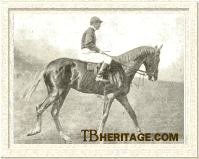
La Farina
| |
LA FARINA (1911), was a striking chestnut colt, very much on the leg, with a flaxen mane and tail, out of imported Malatesta, by Isinglass. He won twice as a juvenile, including the Prix La Rochette. In his second season he placed in the Poule d'Essai, and then beat his great generational rival, Sardanapale (owned by Baron Maurice de Rothschild), in the Prix Daru and the Prix Lupin. He did not run in the Prix du Jockey Club, but met Sardanapale again in the Grand Prix de Paris, and was beaten by a neck, with the Epsom Derby winner Durbar four lengths behind in third. At stud at Meautry he was a very successful sire, in the top ten five times, and third in 1924. He died at Meautry in 1935.
|
La Farina's daughter, the in-bred Crudité, out of Vitamine (and so half-sister to the Rothschild's great champion Brantôme), a grandaughter of Sans Souci, was bred at Meautry and ran for Baran Edouard; she won one of three races as a juvenile. At age three she ran five times, winning two races and finishing third in the Prix Hocquart (by a little over a head) before beating a big field of high-class colts and fillies in the Grand Prix de Paris by a short neck from William of Valence. He also got another good distance filly, Dorina (1923, out of Dora Agnes, by Roi Hérode), bred and raced by Edward Esmond. She won six races at the ages of two and three, including the Prix de Diane, and was second in both the Poule d'Essai des Pouliches and the Prix de l'Arc de Triomphe. Dorina was later the dam of Astrophel (winner of 14-1/2 races), Dulce, Dorinda, and Fox Cub, the latter winner in England of the Criterion Stakes and second to Blue Peter in the 1930 Derby and later a sire in Argentina.
Other good ones by La Farina included La Dame de Trèfle (winner of the Poule d'Essai des Pouliches); Swansea (winner of the Grand Prix de Deauville); Tapin (winner of the Poule d'Essai des Poulains, Prix Greffulhe, and other races in France, and in England the Lincolnshire handicap), later a good sire of jumpers; Lovelace (winner of the Grand Prix de Nice, Prix d'Ispahan, Prix de la Forêt, and seven other good races, and second in both the Prix du Jockey Club and in England, the Eclipse Stakes), later a useful sire in France.
La Farina's most notable son was Bubbles (1925), bred at Meautry, from the mare Spring Cleaning. A half-brother to CADUM, he won the Prix des Chenes and Prix de Conde as a juvenile, won the Prix Lupin and was third in the Grand Prix de Paris at age three, and at age four easily beat the best horses of his time in the Prix du Président de la République. Despite his sojourn in Germany when he was confiscated during World War II, he was a very successful stallion, and in 1938 was leading sire in France, and second in 1939. He got many runners for Baron Edouard, including the in-bred (to Sans Souci) Eclair au Chocolat, champion three year old in 1938 (taken by the Germans during World War II), and Ocarina (1947), also in-bred to Sans Souci, unbeaten in four starts at ages three and four, setting a record in the Grand Prix de St. Cloud. Ocarina ran for Baron Guy de Rothschild, Edouard having died in 1949. Ocarina's brother, Guersant (1949), was Bubbles' best son on the turf and in the stud. He was a winner in France and England of the Poule d'Essai des Poulains, the Prix de la Forêt, the Prix Ganay, the Coronation Stakes and Hardwicke Stakes; he was sold to Japan, where he was leading sire in 1969, and second on that list three times.
Like Sans Souci, LA FARINA was a good broodmare sire. His daughters bred Grand Prix de Paris winner Maurepas, later a sire; Verso, out of an Alcantara mare, winner of the Prix de l'Arc de Triomphe and the Prix du Jockey Club and later a successful sire; the brothers Astrophel and Fox Cub, both later sires, and Vandale, a staying winner of the Prix du Conseil Municipal and later sire of French champion Herbager. LA FARINA's daughter Bertina produced Fortina, winner of the Cheltenham Gold Cup and Lancashire Chase, and one of the most noted sires of steeplechasers and hurdlers in the history of the sport, six times second on the list of leading National Hunt sires in Great Britain.
|
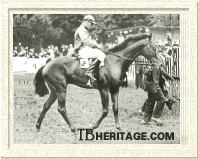
Cadum
| |
CADUM (1921) was out of the Neil Gow mare, Spring Cleaning (1915), whose dam, Spring Night (1907, by Chesterfield) was purchased in England for Meautry around 1910. Spring Cleaning became a key foundation mare for Edouard de Rothschild: her Sans Souci daughter BUANDERIE (1924) produced Bobkul (1932, by Blandford), a good stayer that won the Prix Edgard Gillois and the Prix Royal-Oak for the baron, and another Sans Souci daughter, SPRING TIDE (1926) bred Mousson (1934, by Rose Prince), winner of the Prix de la Forêt, the Grand Prix du Printemps, and other good races, and second in the Gran Premio di Milano and the Grand International d'Ostende. Spring Cleaning was also the dam of the LA FARINA son Bubbles.
|
CADUM won a number of minor races at ages two and three, and at three placed in the Prix Royal-Oak, the Prix de l'Arc de Triomphe (winning, but being placed second for savaging Priori), and in the Prix du Conseil Municipal. At age four he was the best horse in France, winning in succession the Prix de Sablons, the Biennal, the Prix du Cadran, the Prix La Forêt, the Prix du Président de la République, and the Prix du Prince d'Orange, beating all the best horses of his day during this outstanding streak. He was retired to Meautry, getting some useful winners, but he is not ranked among the stud's best stallions.
TACITE (1918, from the Torpoint daughter, Taormina), won four races, including the Prix Greffulhe, and placed second six times, including in the Poule d'Essai des Poulains and the Prix Hocquart). At age four he ran second in the Prix Lupin. In 1923 he was purchased by the brothers Ignacio, Carlos and Mario Valdés and sent to their Haras Cunaco in Chile, where he became a superior stallion, leading the sires list in 1934. Among many good winners he got Farsalia, the best filly of her generation, winner of the Nacional, La Huasca, Las Oaks, and the Club Hípico; another good daughter, Badalona, won the Paddock Stakes, Las Oaks, Copa Jackson, Andrés G. Scott, and the Gran Premio Viña del Mar. La Sota, winner of the Augustín R. Edwards and the Cátulo, also won the Jockey Club Argentino in that country. His son, Alma Tadema won La Prueba and other races, and was later a useful sire. Tacite was also a good broodmare sire whose daughters produced a number of classic winners in Chile. He died in the early 1930s.
ZAGREUS (1917) was out of Zingara (1901), a Le Sancy daughter purchased for Meautry in 1901 that became one of its best foundation mares. ZAGREUS , sold to Mr. Ambatielos, won the Grand Prix de Deauville and the Prix La Rochette; his offspring were initially sales-toppers at the Deauville yearling sales. His younger brother, SANS LE SOU (1910) was a good runner that won the Prix Eclipse and a number of trials during World War I, beating Teddy in 1916 in the Prix d'Elevage. Their sister, ZANETTA (1920) produced Prix Noailles winner Zenodore (1931), and was second dam of Prix du Cadran winner Chaudiere. A tail-female descendant of ZANETTA'S, Nasr El Arab (1985), was winner of the Prix Hocquart, and was sent to California, where he won the Carleton F. Burke Handicap and the Oak Tree Invitational Handicap.
LE GROS MORNE (1921, out of Marigot, by Simonian) was the best juvenile of his year, winner of the Prix Nozay at Maissons-Laffitte and l'Omnium. At age three he won the Prix Lagrange, the Prix Biennal (beating Scaramouche and Pot au Feu in both, the Prix La Rochette, and he was second to Transvaal in the Grand Prix de Paris. Injury sent him into retirement, and he was sold to Baron de Koeppen and sent to stud at Haras du Buisson, Merville.
|
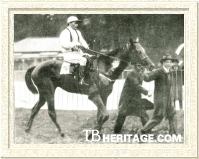
Rocking Chair
| |
Other Sans Souci sons that ran well included SENS (1919), out of Yonne, by Eryx, winner of the Prix Jean Prat; DONATELLO (1926), from Rochetta, by Alpha, and a close relative of LA FARINA'S, who took the Prix Daru; CHERRY BRANDY, HAPPY GO LUCKY, MANOIR, and many others.
Sans Souci and his sons also got a number of good winners over fences. One was ROCKING CHAIR (1919, out of Bercleuse), a good juvenile on the flat for Baron Edouard that placed second to Ramus in the Prix de Condé at Longchamp and won the 2000 meter Critérium de Saint-Cloud (for juveniles), and whose victories over obstacles in later years included the Grande Course de Haies in 1925.
|
Sans Souci's Daughters
Sans Souci got some good running daughters, including the top filly FLORAISON and the French 1,000 Guineas winner NEPHTHYS. But it was in the stud, mostly at Meautry, where his daughters really made a mark, and it is largely through them that he is seen in pedigrees today. His daughters bred many classic winners in France, including four Prix de Diane winners and three winners of the Prix Royal-Oak, and were dams or second dams of such stallions as Vatout and Brantôme. A number of his daughters were from families that had been at Meautry for several generations, or founded families at Meautry that would last through the twentieth century. Many were bred to home-bred stallions, such as LA FARINA and Bubbles, but Edouard de Rothschild did not lock himself into the homebred stallion trap, as did his contemporary, Marcel Boussac, and he often utilized outside stallions and purchased outcross stallions.
Right off the bat Sans Souci's daughter FLORAISON (1909, from Meautry foundation mare Floretta, by Florizel), bred at Meautry, won four good races for Baron Edouard at age three: the Poule d'Essai, the Prix Semendria, the Prix Daru, the Prix Lupin, and the Prix du Prince d'Orange, which made her the best filly of her year. She was later second dam of a good runner in Arbaletrier (1926, Prix Jean Prat, Prix Langrange, and other races). Her dam, Floretta, also produced SUNFLOWER (1910), to the cover of Sans Souci; SUNFLOWER was one of the better juveniles of 1912, but failed to hold form. However, as a broodmare at Meautry she was put to Baron Edouard's 1911 Prix du Jockey Club winner Alcantara, and dropped the outstanding Rothschild-owned filly Flowershop (1917), winner of the Prix de Diane, the Poule d'Essai des Pouliches, the Prix Greffulhe, Prix Henry Delamarre, and other races. In 1924 Sunflower was put to the Rothschild stallion Bay Cherry, and in 1925 produced Nopal, a winner of the Prix Edgard Gillois.
Floretta also produced the chestnut filly FLUSHING (1914) to the cover of Sans Souci. She became second dam of two good Meautry products, the in-bred Godiche (1927, by La Farina), winner of the Grand Critérium, and Hetre Pourpre (1928, by Bay Cherry), winner of the Grand Prix de Vichy. A third Floretta-Sans Souci daughter, FLOWERLESS, bred Serre Chaude (1929, by Blandford), a winner of the Prix Henry Delamarre.
In 1902 Baron Edouard bought the Bona Vista daughter Ambrizette (1897) in England, bred to Ayrshire. She dropped her Ayrshire filly, Ambrosine at Meautry in 1903. She was the founder of a very successful family at the Rothschild stud. Her daughter by Sans Souci, SANS TACHE (1910) bred Samourai (1915, by Alcantara), who won the Prix du Cadran and the Prix Ganay, and his sister, Alba (1920), winner of the Prix La Rochette and later dam of Alcindor (1932, by Brûleur), winner of the Priz im SSSR in Moscow. SANS TACHE'S full sister, HONEY (1911) bred Honeysuckle (1919, by Bay Cherry), the dam of Jus De Raisin (1928, by St. Just), winner of the Coupe d'Or (Maisons-Laffitte) and Prix de la Forêt and second in the Poule d'Essai des Poulains). Honeysuckle's daughter, Honey Sweet (1927, by Kircubbin), produced the in-bred Eclair Au Chocolat (1935), by Sans Souci's grandson, Bubbles. Eclair Au Chocolat, like many Sans Soucis, was a slow-maturing colt, but at age three was the champion of his year, winning the Grand Prix de Vichy, the Prix Royal-Oak, and the Prix de l'Arc de Triomphe in succession. His half-sister, Alix (1937, by Brantôme), won the Windsor Castle Stakes in England.
Yagha (1902, by Dolma Baghtché), won two small races in her nineteen starts between the ages of two and four. She was installed at Meautry as a broodmare, and her daughter Nectarine (1908), by Zinfandel, won the Criterium at Maisons-Laffittee. Nectarine bred seven winners at Meautry, including Sans Souci's daughter NEPHTHYS (1918), winner of the Poule des Poucliches for Baron Edouard, and her sisters, TREILLE DU ROI (1922), a minor winner, and NITOCRIS (1914). The latter, who ran once unsuccessfully as a juvenile, was bred to Alcantara, and produced Kefalin (1919), winner of the Grand Critérium, and at age three the Prix Greffulhe and the Grand Prix de Paris. TREILLE DU ROI, also a broodmare at Meautry, produced Vendange (1930, by Belfonds), winner of the Prix de Diane for Baron Edouard; Vignes du Seigneur (1932, by Biribi), winner of the Prix Eugene Adam, Bacchus (1936, by Bacteriophage), whose big wins for Baron Edouard included the Prix Greffulhe and the Prix Lupin, and Le Pampre (1938), winner of the Prix Jean Prat.
The unraced VIRIDIFLORA (1912), bred by Auguste Aumont, was out of the Le Sancy daughter, Rose Nini; Rose Nini had been purchased in England for a small sum, and at Aumont's stud bred seven winners, including Prix de Diane winner Rose Verte. Purchased for Meautry, she produced five winners, including Vitamine, Verte Feuille, Viburnum, and Conway, the latter winning some races in England. Vitamine (1924, by Clarissimus), winner of the Prix Jacques le Marois and three other races, later bred Prix Jacque le Marois winner Electron (1929, by Blandford) and his brother, the great champion Brantôme (1931). Brantome was unbeaten at ages two and three, winning nine races, including the Prix Robert Papin, Prix Morny, and the Grand Critérium (comprising the two-year-old "Triple Crown"), the Poule d'Essai des Poulains, the Prix Lumpin, Prix Royal-Oak and the Prix de l'Arc de Triomphe; he did not run in the Prix du Jockey Club and the Grand Prix de Paris because he was coughing and the stable wouldn't risk him. At age four he won the Prix du Cadran and the Prix du Prince d'Orange. He, like all the Meautry horses, was impounded by the Germans by World War II, and he was shipped off to Germany; after the war he was repatriated and resumed stud duty at Meautry. His best son was the Grand Prix de Paris winner Vieux Manoir, leading sire in France in 1962. Another Vitamine offspring was the grand filly Crudité (1932), by LA FARINA, and so in-bred to Sans Souci. She won the Grand Prix de Paris.
|
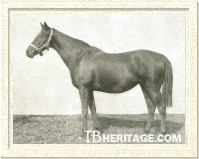
DÉSIRADE (out of Marigot, by Simonian) was a full sister to LE GROS MORNE. She and SÉLÉNÉ (below), dam of Prince d'Orange, a big winner in Romania, were both broodmares at the Auteuil stud of Robert Lazard-et-Sibilat, where the stallion Jus d'Orange (by the Rothschild stallion St. Just) stood.
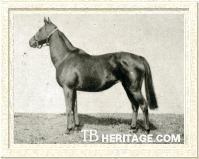
Séléné
| |
BLUE PILL (1913) was out of Magnesie, by Krakatoa, a mare that traced back three generations in France to the Grosser Preis von Baden winning mare Capucine (1857), by Gladiator. At Meautry Blue Pill produced two outstanding fillies for Baron Edouard: Cerulea (1923, by Bay Cherry), a grand staying winner of the Prix Boïard, the Prix La Rochette, and the Prix du Conseil Municipal, and Perruche Bleue (1929, by Biribi), winner of the Prix de Diane. Perruche Bleue was second dam of Ombrette (1948, by Cranach), winner of the Grand Prix Vichy and, in her turn, a broodmare at Meautry. The useful stallion Blue Skies (1927, by Blandford), sire of Septieme Ciel, the 1948 winner of the Grande Course de Hais d'Auteuil (5,000 meters) was also a son of BLUE PILL.
PROSOPOPÉE (1916, from Peroraison by Tarporley) ended up in the stud of Baron Edouard's cousin, Baron Maurice de Rothschild. She produced ELEUSIS (1922, by Sardanapale), winner for Baron Maurice of two starts as a juvenile and placed in her other four efforts that year, and at age three winner of the Prix de l'Yser (1300 meters) and the Prix Saint-Roman (1800 meters, at Longchamp). A number of Prosopopée,'s daughters by Sardanapale were purchased to the U.S., the most notable being Sekhmet (1929), who bred Booklet (1938) a winner and later good broodmare in England, and William Woodward's good filly Segula (1942), a winner of nine races and later dam of a top filly Sabette and of the champion juvenile and Horse of the Year, Nashua.
|
OUCHE (1916, from Oussouri, by Chesterfield) was sold to Argentina, where she became the dam of Plutarco, winner of the clásico Raúl Chevalier. VOLIERE (1916, from the Gallinule daughter La Faisanderie) was sold to Italy, where she bred Varedo, winner of the Polla de Potrillos, the Presidente de la República, and the Gran Premio de Italia.
CORONILLE (1918), out of Coraline, by Henry the First, became the dam of Cacao (1925, by Bay Cherry), a good stayer and winner of the Prix du Cadran and Prix Royal-Oak for Baron Edouard.
ORIANE (1920), from the grand Meautry foundation broodmare Queen Mab, had a brief career on the turf and died early, at age eleven, but she left two good fillies that bred on: Elgire (1927 by Royal Dancer), and Reine Isaure (1931, by Blandford), one of the better fillies of her generation at age three, and dam of four winners, including the grand stayer Cranach, stolen by the Nazis and winner of eleven races in Germany before being restored to Meautry in 1946, where he was a successful stallion.
BASILISQUE (1924, out of Verine by Sly Fox, related to Floretta) won the Prix Miss Gladiator. Her dam's sister, VASTHI (1921), was by Sans Souci, and in the stud produced the good runner Vatout (1926, by Prince Chimay), a successful stallion in France that sired Epsom Derby winner Bois Roussel, the sturdy running Vatellor (leading sire in France in 1956), Jockey Club Cup winner and sire Atout Maitre, and other good horses.
Sans Souci's daughter CARAVELLE (1924) was out of Sea Moss (1917), a Meautry broodmare by William the Third purchased in England in the early 1920s. She produced two good fillies: Cocque de Noix (1930, by Epinard), winner of the Prix Robert Papin, and Péniche (1932, by Belfonds), winner of the Prix de Diane and second in the Prix de l'Arc de Triomphe.
Sans Souci died in 1925, which was the year he was, for the second time, leading sire in France. He left behind La Farina, who continued the sire line, and many successful broodmare daughters.
--Patricia Erigero
|
|
|
|

